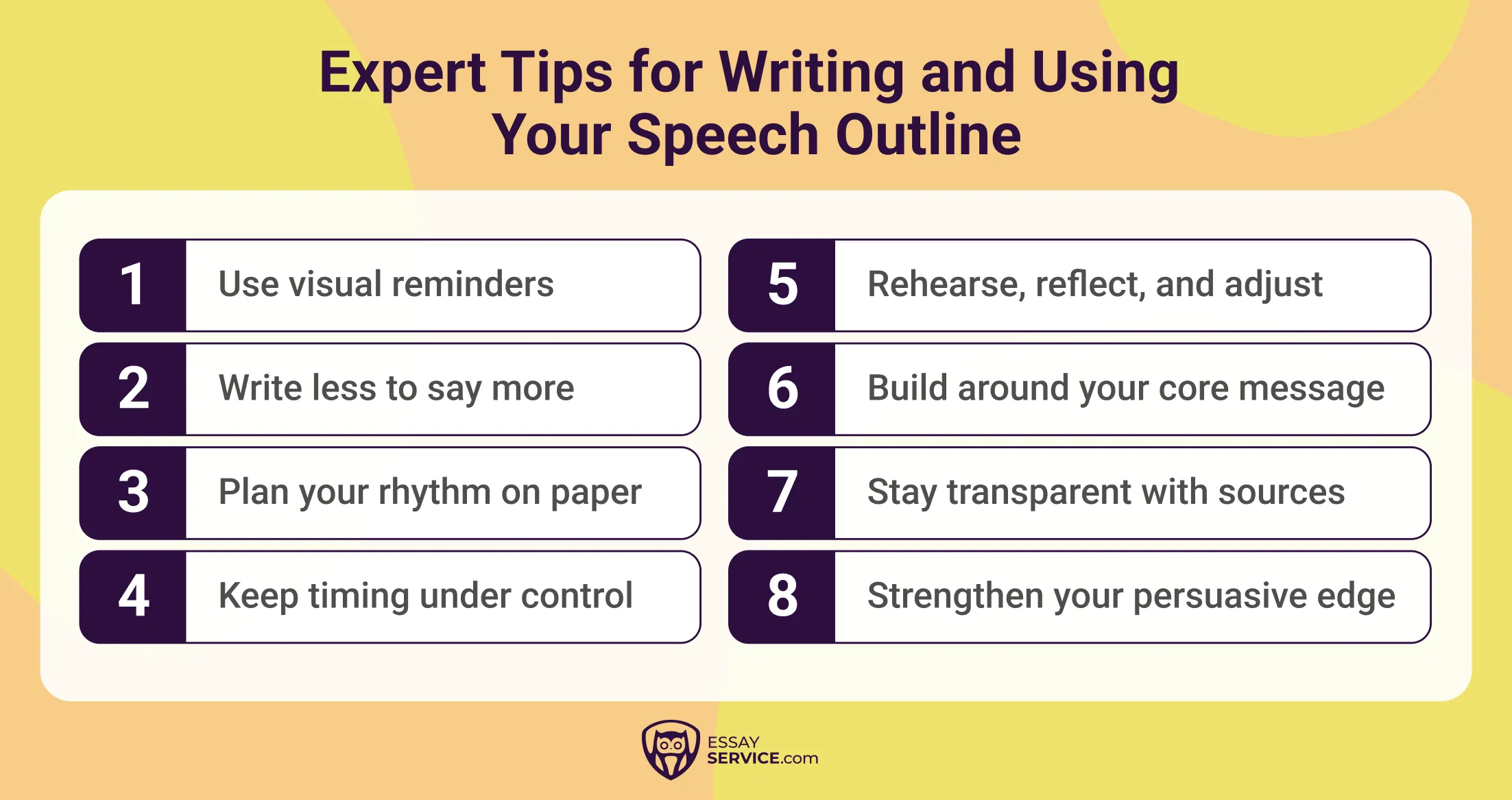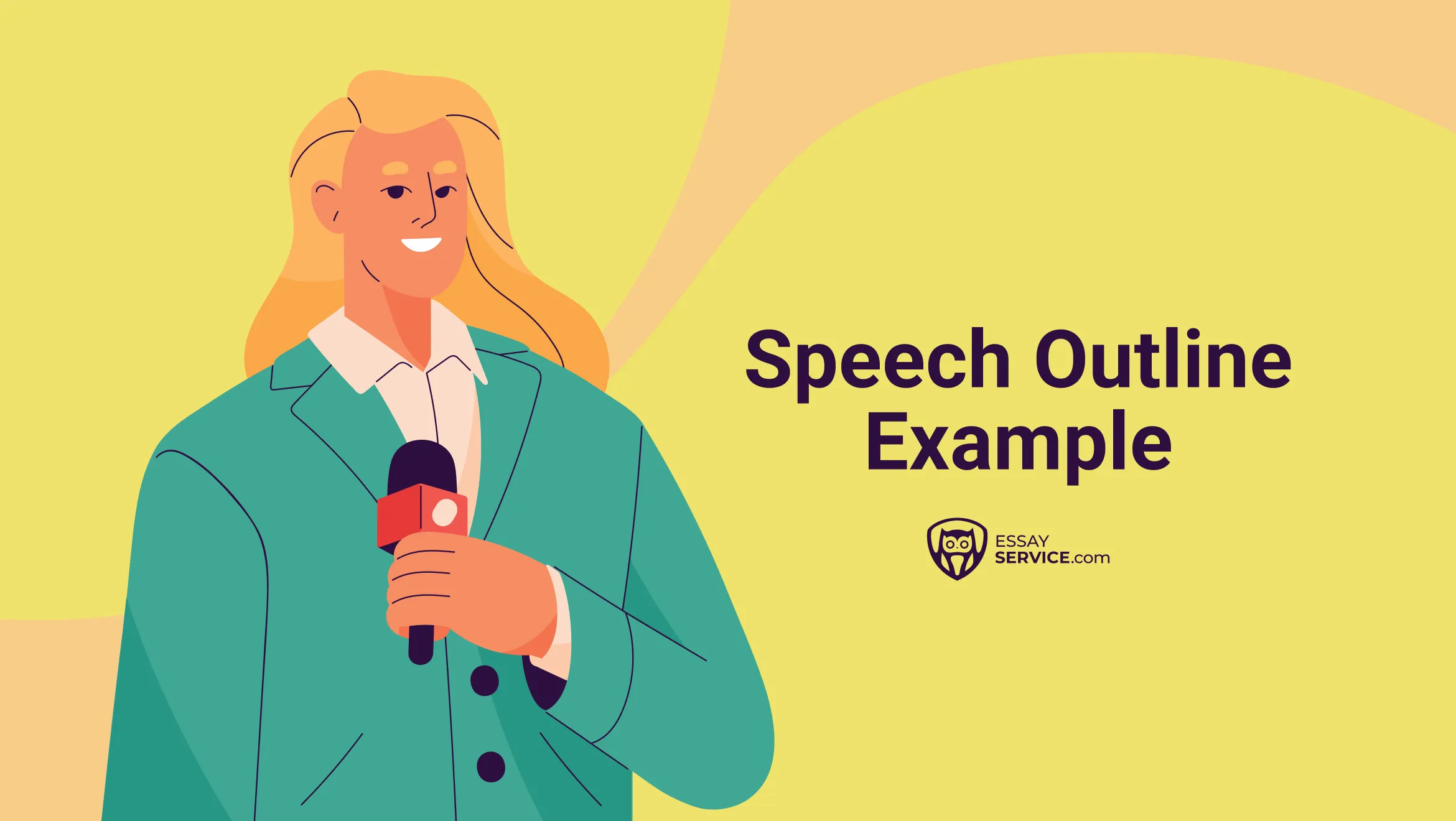Every student who’s ever given a speech knows that every pause and misplaced sentence can have a huge impact. Studies show that about 75% of people experience public speaking anxiety, which only gets worse when the structure of the talk is unclear.
This article breaks that cycle. It gives you a speech outline example for students, helping you organize and deliver your ideas with confidence.
If you find yourself spending more time worrying about speech outline formatting than writing your speech, there’s no shame in getting extra help. In those moments, EssayService can make a difference. Our essay writing service connects you with experts who understand academic structure inside out.


EssayService Supports Every Student Speaker
Let us help you organize ideas and shape them into a powerful message.
Explaining a Speech Structure
A speech outline is the framework that gives your ideas order and direction before you step up to speak. It creates a sequence of main ideas that move naturally from one moment to the next. Every speaker needs a map that connects key arguments, examples, and transitions into one clear flow.
Two main versions guide this process.
- The preparation outline includes full sentences, transitions, and supporting evidence that help you organize and refine your message.
- The speaking outline uses short cues and keywords that help you stay present while delivering your speech.
A well-built outline supports confident delivery and keeps timing steady. It also helps the audience stay focused on your message. If you are still exploring potential ideas, check these topics for informative speech to find subjects that connect naturally with your purpose and style.
Downloadable Speech Outline Examples
Every great presentation starts with a clear plan. To help you see what that looks like in practice, we’ve included two speech outline example PDF files you can download for free.
The first is a detailed speech preparation outline example, ideal for planning, research, and organizing every section of your speech.
The second is a speech speaking outline example, designed with short cues that keep your delivery smooth and natural.
Template for a Speech Outline
Use this step-by-step template to organize any speech. For assignments where you have to prove your point in front of an audience, this guide pairs well with our walkthrough on how to write a persuasive speech.
How to use this template
- Draft a preparation outline with full sentences and sources.
- Convert it into a speaking outline with short cues, time marks, and delivery notes.
- Keep parallel structure across main points so your message sounds balanced.
Title and Purpose
Title: State the exact topic and the outcome you want. Make it short and specific.
Purpose: The purpose explains why you are speaking and what change you want to create in your listeners. Decide what the audience should know, feel, or do by the end.
I. Introduction
- Attention getter: a vivid fact, a sharp quote, a brief story, or a pointed question.
- Thesis: one sentence that names your central idea.
- Motivation: why this matters to this audience today.
- Preview of main points: two to four items in the order you will follow.
- Transition: one line that leads into the first main point.
Timing tip: 10-15 percent of total time.
II. Body
Plan two to four main points. Each point should look and sound similar in length and tone.
For each main point:
- Claim or topic sentence.
- Sub points that develop the claim.
- Evidence or examples: data, expert views, brief stories.
- Mini-summary to lock in the idea.
- Transition to the next point.
This structure prepares your outline for stronger flow and clearer direction, which leads into the next stage of planning:
Signposting you can use: 'First,' 'Next,' or direct guidance like 'Now shift to the second point.'
Timing tip: 70-80 percent of total time.
Adapt by speech type
- Informational: define terms, compare categories, explain causes and effects, add clear visuals.
- Persuasive: state a claim, give reasons, include one strong counterargument with a reply, and end each point with an impact on the audience.
- Demonstrative: list materials, show steps in order, add safety or quality checks, and include a quick troubleshooting note.
III. Conclusion
Recap the main points in the same order.
- Closing line: a call to action for persuasive work, or a memorable takeaway for informative or demonstrative work.
- Clincher: circle back to your opener with a final image or fact.
Timing tip: 10-15 percent of total time.
Use this template as your default structure. Adjust depth, examples, and transitions to match your audience and the time you have.
Here’s a quick checklist for delivery and setup:
- Write speaking cues such as 'eye contact,' 'pause,' 'slow down,' or 'show slide 3.'
- Mark time goals next to each section.
- Add slide numbers and figure labels to match your outline.
- List sources you will mention out loud.
- Print one page per section for easy reading, or put your cues on note cards.
EssayService Makes Public Speaking Easier
From structure to tone, get help crafting your next presentation or speech.
Speech Outline Template Example
This free template gives you a clear framework you can adapt to any topic or audience. Whether you’re setting the stage for an informational talk, a persuasive presentation, or a step-by-step demonstration where you describe a topic practically, download this PDF to deliver with confidence.
Expert Tips for Writing and Using Your Speech Outline
A well-designed outline trains your mind to think like a speaker. Here’s how to make it work for you:

- Write your thesis and a first point, then build everything else around them. This keeps your outline anchored in purpose rather than scattered with filler ideas.
- Use keywords instead of sentences so your delivery feels natural and unrehearsed. Reading full lines often flattens your tone and eye contact.
- Mark pauses, tone shifts, and emphasis directly on the page. A quick cue like (pause) or (slow down here) can completely change the rhythm of your speech.
- Add time checkpoints beside each section because small time goals keep you from rushing or dragging.
- Practice aloud with your outline in hand, and update it each time you run through. A good outline evolves as you notice what feels clunky or what sparks real audience attention.
- Include a visual trigger for complex parts, like underlining a word that reminds you of a story or image. Memory works best through association.
- Always attach a short bibliography or reference list to keep your facts credible and easy to verify.
- And if you’re shaping a persuasive message, check out these persuasive speech ideas to refine your topic and align it with your audience’s interests.
The Bottom Line
A well-structured outline should be the core of your speech strategy, because it actually teaches you how to think like a communicator. You can use a simple speech outline example that we’ve shared above before your next speech to make sure you deliver with confidence.
And if you don’t have time to structure and write your speech, our speech writing services can step in. Other than our samples for high school and college students, we offer guidance from expert writers who can take care of your next presentation.
Frequently Asked Questions
How Long Should a Speech Outline Be?
A speech outline should be as long as needed to organize your ideas without overwhelming you during delivery. Most preparation outlines range from one to three pages, depending on the speech length. Speaking outlines are much shorter, usually one page of brief cues or phrases.
How Do You Write a Speech Outline?
Begin by defining your topic and purpose. Then list your main points in a logical order and add sub-points with examples or evidence. Use clear transitions between sections and end with a strong conclusion that reinforces your message.
What Are the Three Main Parts of a Speech Outline?
Every basic speech outline includes three main sections: an introduction, a body, and a conclusion.
- The introduction helps you grab the audience’s attention, keep them interested, and give background information.
- The body explains your main points with support.
- The conclusion generally summarizes key ideas and leaves a final impression.
What’s the Difference Between a Preparation Outline and a Speaking Outline?
A preparation outline is detailed and includes full sentences, research, and references, and is used for planning and organizing content. A speaking outline is brief and designed for delivery. It uses short keywords, transitions, and cues to help you stay on track while presenting.
Where Can I Find a Speech Outline Example?
You can find an example of speech outline with detailed explanations and templates on EssayService. We provide student-friendly samples, along with guidance from expert writers to help you plan and structure your next presentation.
.png)
Jaroslav specializes in helping students unlock their creative side and let it shine. Armed with his Bachelor’s degree in creative writing, he imparts his advice on making communication effective and engaging.
- Grand Valley State University. (n.d.). Outlining: Introduction, body, conclusion. Speech Lab. https://www.gvsu.edu/speechlab/outlining-introduction-body-conclusion-31.htm
- Sam M. Walton College of Business. (n.d.). Outlining your speech. Business Communication Lab, University of Arkansas. https://walton.uark.edu/business-communication-lab/resources/downloads/final-outlining-your-speech-resource.pdf
- Western Oregon University. (n.d.). Speech outlines and organizational patterns. Hamersly Library. https://research.wou.edu/c.php?g=551207&p=3784408
New posts to your inbox
Your submission has been received!




